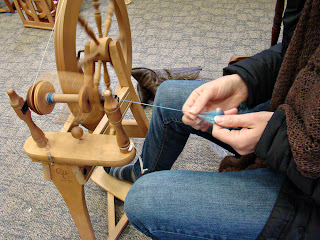Quiet, steady treadling. Even, regular pulling.
Twisting, drafting, twisting, drafting.
It's mesmerising and very very calming.
It looks so easy.
And it is. Unless you've never spun before. Then it's not easy, it's a lot of other things.
Like frustrating. And terrifying. And frustrating. And difficult. And frustrating.
It's really frustrating.
This is what you have to do to spin yarn: with your hands, draft only as much fiber as you want for your yarn, let it twist exactly as much as you want, let the yarn go onto the bobbin without breaking the yarn, draft quickly enough that the yarn isn't getting overspun before it goes onto the bobbin. And while you're figuring that out, you have to treadle with your feet at exactly the speed you need for your yarn.
At the Fiber Frolic at White Violet Center at St. Mary of the Woods College [near Terre Haute], four brave women gathered for three days to learn how to spin. Three of them had a little experience with a wheel or spindle. One had never tried to spin at all. I was their teacher.
There are several stages that one goes through when learning to spin. Most people come to the wheel thinking that it can't be too hard. Spinning looks easy.
Five minutes at the wheel sends them straight to the 'Why did I think this was a good idea??' stage. This stage lasts for many hours of practice. A lot of people quit during this stage. My experience is that the only people who never 'get it' are the people who quit during this stage.
Anyone who is willing to stick to it long enough to get to the other side of the 'Oh, crap' stage, is going to learn to spin.
 This
is when I remind people that no one sits down at a piano for the first
time and plays a sonata. It takes time to learn the instrument. It
takes patience and practice.
This
is when I remind people that no one sits down at a piano for the first
time and plays a sonata. It takes time to learn the instrument. It
takes patience and practice. The next stage is the Aha! stage. After fighting the wheel, the treadle and the roving for what seems like years, and after having to wind yards and yards of overtwisted rope onto the bobbin by hand, suddenly the new spinner drafts only a small bunch of fibers and makes a finer yarn. Fine yarn takes a lot of twist and when you spin fine yarn, everything slows down. With fine yarn, you have time to think and draft and treadle and let it go on to the bobbin. Fine yarn is your friend.
The first Aha! moment lasts approximately a nanosecond, but I promise you that there will be more Aha! moments. And sooner than you believe, the Aha! moments will be coming closer together. And then, you'll have an Aha! that lasts a whole 5 minutes.
 At
which time, the spinner catches a glimpse of the 'Oh, this is what I do
when I go like this' stage. It takes a few more hours of practice to
fully achieve the 'Oh, this is what I do when I go like this' stage, but
only a few.
At
which time, the spinner catches a glimpse of the 'Oh, this is what I do
when I go like this' stage. It takes a few more hours of practice to
fully achieve the 'Oh, this is what I do when I go like this' stage, but
only a few.It's important to take a lot of breaks when you're learning to spin. Just standing up and getting away from the wheel can help. Often beginning spinners say that they had a very hard time at first, but after taking a long break of a few days or weeks, they can sit down and everything clicks. They are able to make great strides in finessing their skill.
Our spinning newbie was one of the most patient and even tempered new spinners that I have ever seen. She persevered and by the end of the retreat, she had this beautiful skein of plied yarn to show for it.
Congratulations to all of my new spinners!




